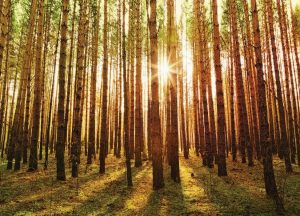Back to our roots: Revitalization of forest products industry
By Lyndsay Vander Toorn (Posted July 30, 2019):

A surprising threat to forest retention is poor markets. Reduced demand for forest products means less incentive to retain forests.
Before plastic was an option, we carried our items out of the grocery store in a simple paper bag. It worked — until something more durable (with handles) came along. “Paper or plastic?” That became the question, and plastic became the far more common answer. Paper bags quickly took a backseat to the modern, more convenient plastic ones.
Plastic companies wasted no time marketing the lighter and reusable product. Over time, plastic production replaced a variety of items once made by the forest products industry — especially in packaging. People and businesses felt good about their choice of plastic; they were “saving trees,” after all.
Now, plastic products and packaging are here to stay — in some instances for good reason. The healthcare industry and food production industry rely heavily on plastic packaging for sanitation and cleanliness. This gives us the luxury of keeping food fresh longer by using plastic in both production facilities and at home.
But all too often luxuries come with costs. Failure to recycle plastic material is contributing to massive pollution problems such as “trash islands” and microplastics in our oceans. On land, habitats and species are threatened as plastic dumpsites (approved or otherwise) proliferate, not to mention the unsightly waste along streets and in streams. To keep pollution in check, each person must realize the importance of recycling used plastic products and avoiding unnecessary single-use plastic items. Currently, less than 10 percent of plastic products are recycled, while nearly 70 percent of paper products are recycled, notes the American Forest and Paper Association. People are re-evaluating their choices now that they see the consequences of creating products with a material that does not have a natural life cycle and can be a challenge to recycle or destroy. There will always be a need for chemical-based products such as plastic. We, as a society, must be more conscious of how often we use it and must focus intently on better alternatives.
Turning the tables
Since paper is recycled at a much higher rate and is biodegradable, the forest products industry is turning the tables on the plastic industry in terms of competition and innovation. The forest products industry can be considered a circular economy, an economic system that minimizes waste and makes the most of its resources. The plastic industry cannot be considered a circular economy because so much indestructible waste is created and, if uncontrolled, carries a heavy environmental legacy.
The forest products industry, in fact, can mimic advantages of plastic, without the consequences. Technological advances at the nano-level (nanocellulose — a nanometer is 1 billionth of a meter) have given the forest products industry a pathway to create plastic-like material that is just as durable and is biodegradable. Among the many ways to produce nanocellulose is one of feeding wood pulp to algae. This makes it incredibly inexpensive to create in bulk — and it is environmentally friendly. It is light, strong, and can conduct electricity. Some products that are made with nanocellulose include body armor — stronger and lighter than Kevlar — and flexible screens, which can be used instead of glass or plastic.
Seeing the value of the forest
In a capitalistic society, the bottom line can seem to be all that matters. Shareholders must see value in their investments. Environmental concerns also come into play when investors choose where their money goes. It is still common to hear consumers mention pulp and paper facility pollution, but most are unaware of the strict environmental regulations that minimize adverse impacts. Deforestation is also a common concern and is true where lands are converted to agriculture or development. But trees and entire forests are renewable. They are the Energizer Bunny of resources — they just “keep going and going.” After a timber harvest, depending on where one is in the country or the type of trees desired, the landowner either could let the forest naturally regenerate or plant desired species.
Either way, there are surprising facts: The amount of timberland (land in forests available for management) in the U.S. South increased slightly over the past 60 years to almost 200 million acres, even in the face of rapid population growth that roughly doubled over the same period. This near-magical feat — retaining forest acreage and increasing forest productivity, despite doubling forest harvest to meet product demand from a rapidly increasing population — is the result of research investments by industry and federal/state natural resources agencies and the commitment of forest owners to practice active management.
“While these results may seem counterintuitive at first glance, they make sense,” says Carlton Owen of the U.S. Endowment for Forestry and Communities. “The bulk of Southern forests are owned by families. Most of these families need income from their forests to pay for taxes and other life expenses. When there are strong markets for forest products, there is incentive to keep forests and ensure their health.” A surprising threat to forest retention is poor markets. Reduced demand for forests products means less incentive to retain forests. Not many think of the forest as a “market” or a place of investment, but industry experts know differently.
Owen notes: “Forests need markets. Lost markets equals lost forests.” He also thinks we should consider the entire life cycle of a product, and that we might have to “go back to the future” in a sense. This means going back to a more responsible choice for the security of our environmental future. Examining fossil fuel products against forest products is a classic example of evaluating a product’s life cycle. The forest is a renewable resource; fossil fuels will eventually run out. When put in those terms, consumers might better understand the need to modify product choices.
Forest Products Century
Owen, a member of the SynTerra Board of Directors, has deemed the 21st century the “Forest Products Century.” We must depend more on the natural preventative and corrective powers of nature, he says, and to do so, we must be mindful about avoiding environmentally harmful behaviors. He is adamant that we must limit single-use plastics as much as possible. He also is adamant that the forest products industry must continually seek technological advances. Owen maintains a leadership role in such innovation. Ongoing projects include parking lots paved with nanocellulose-infused concrete (which emits less carbon dioxide) and fire-resistant mass timber (used for construction).
We have only one home. Decisions regarding product choices should be responsible, mindful, and what is best for the environment overall. The consequences of placing convenience above all else are already being felt worldwide and ocean-deep. At SynTerra, we are proud of the contributions we’ve made to the forest products industry over the past 27 years. We work with our clients to reduce waste generation rates and identify beneficial uses for process residuals. Repurposing dewatered fiber from wastewater treatment systems to function as the barrier layer in a landfill cover system is an example. Another is the use of large diameter geotextile tubes for wastewater treatment sludge dewatering. We look forward to our continued participation in the exciting and essential revitalization of the forest products industry.





